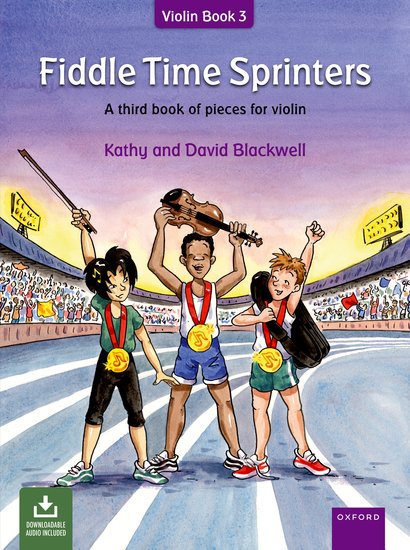By Kathy Blackwell
A friend once asked if I ever get bored teaching the violin and doing the same thing year after year. He was surprised when I said “It’s anything but dull and boring!” I have always enjoyed the unique character and style of each student, and it’s a privilege as a teacher to see them develop over the years.
Today began in a Junior School with pupils from beginners to Grade 3. The beginners are a lively and enthusiastic bunch eager to show off what they have achieved in their week’s practice. We sing “Jelly on a plate” and play it both pizz. and arco. I’m delighted that bow-holds are shaping up well and we have a lot of fun with a bowing song where we place the bow on our head, nose, and chin. Stickers all round if they manage to keep thumbs bent and curly little fingers on top of the stick.
 For those students who are working towards an examination I hear the scale/arpeggio rota for that day. Pupils at all levels find chunking up the technical requirements into a 3 or 4 day rota an effective way to cover the examination syllabus. We try to get variety into the scale practice playing them as rounds, duets, and with different violin and piano accompaniments. I get pupils to draw a small face by each scale depending on how well they think it’s going: a smiley face when they feel it’s secure and can be played without hesitation, a straight line mouth if it’s nearly there but needs a bit more work, and an upside down smile if it’s unsure and hesitant. It’s satisfying for all to see the upside down smiles become proper smiles over the term.
For those students who are working towards an examination I hear the scale/arpeggio rota for that day. Pupils at all levels find chunking up the technical requirements into a 3 or 4 day rota an effective way to cover the examination syllabus. We try to get variety into the scale practice playing them as rounds, duets, and with different violin and piano accompaniments. I get pupils to draw a small face by each scale depending on how well they think it’s going: a smiley face when they feel it’s secure and can be played without hesitation, a straight line mouth if it’s nearly there but needs a bit more work, and an upside down smile if it’s unsure and hesitant. It’s satisfying for all to see the upside down smiles become proper smiles over the term.
A lot of my non-teaching time is taken up by writing projects and answering emails from our website. Contact with other teachers and hearing of their experiences is a lovely aspect of writing music books.
The late afternoon session is a return to teaching and a rewarding lesson playing “Remembrances” from Schindler’s List with a 6th former preparing for Grade 8. Last year she watched the film as part of her GCSE RE lessons and this gives us a good starting point for the interpretation of this emotional music. Finding these cross-curricular links greatly enriches the learning process. We discuss the bow’s point of contact on the string and work on tone production. From “Jelly on a plate” in the morning to John Williams in the afternoon — who could ever say it was boring!
Kathy Blackwell studied music at Edinburgh University and continued with post-graduate studies in music at the University of Oxford. Kathy is a string teacher with many years’ experience of teaching violin and viola. She was a strings consultant for the ABRSM Music Medals, and a contributor to the accompanying book All together! Teaching Music in groups (ABRSM, 2004). She has worked for Music Services and privately and her teaching experience has led her to co-author Fiddle Time, Viola Time, Cello Time, and String Time with her husband, David.
This article first appeared in the ESTA magazine. ESTA is the largest branch of the European String Teachers Association with a growing membership with substantial benefits for teachers which include: public liability insurance, legal advice, publications for teachers and young string players as well as events and repertoire suggestions.
Subscribe to the OUPblog via email or RSS.
Subscribe to only music articles on the OUPblog via email or RSS.
Oxford Sheet Music is distributed in the USA by Peters Edition.
Image Credit: Photo provided by the author.


Recent Comments
There are currently no comments.